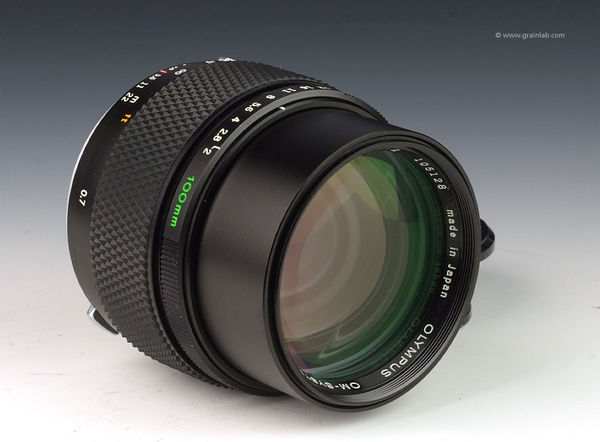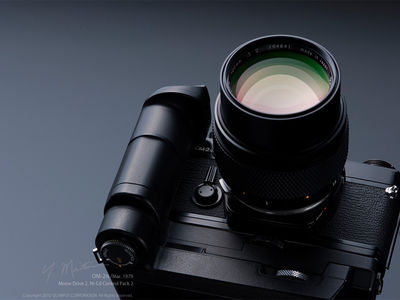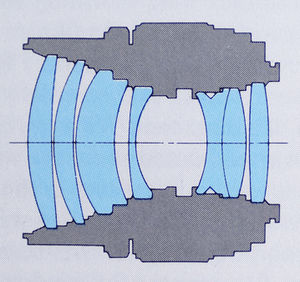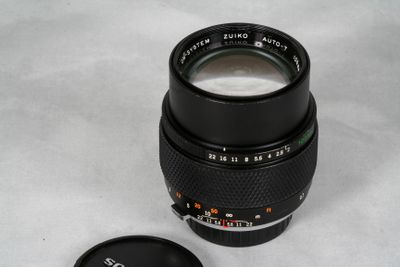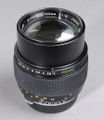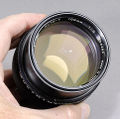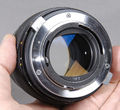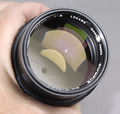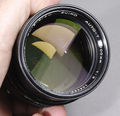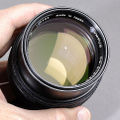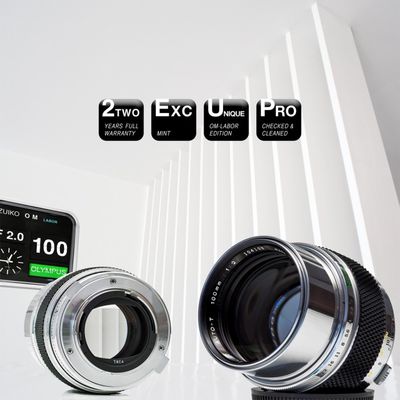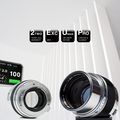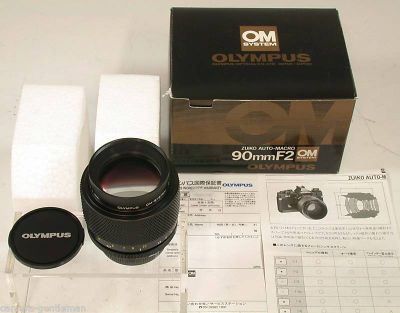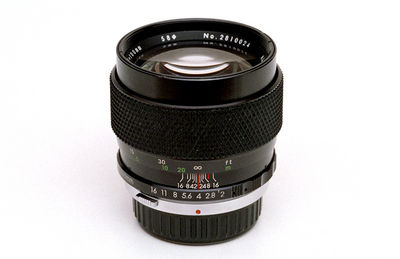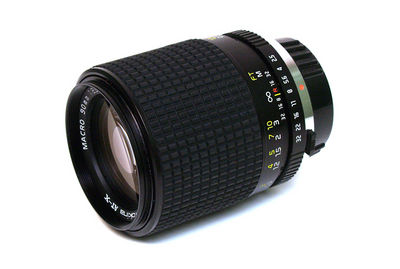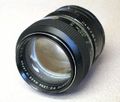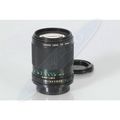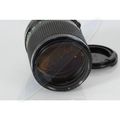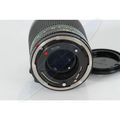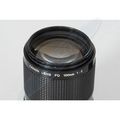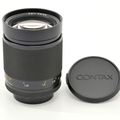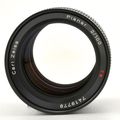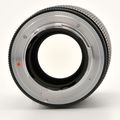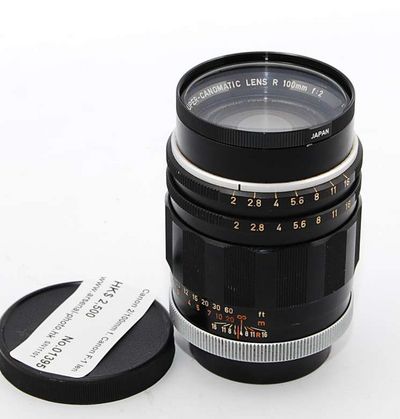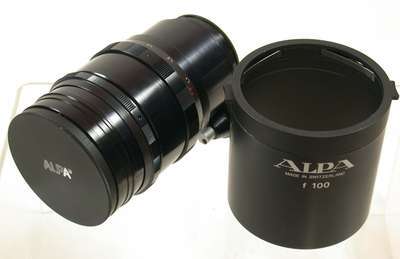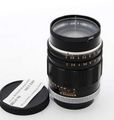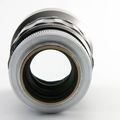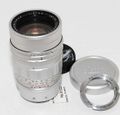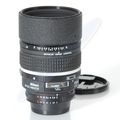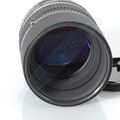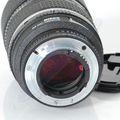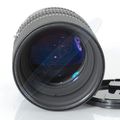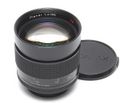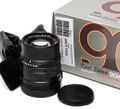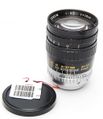Zuiko Auto-T 1:2/100 mm
Beschreibung
Zuiko Auto-T 1:2/100 mm Teleobjektiv
Die lichtstärkere Variante der Zuiko-100-mm-Festbrennweiten im OM-System. Floating elements und Gläser mit niedriger Dispersion - von der Frontlinse aus gesehen:
(Quelle) - führen schon bei offener Blende und im Nahbereich zu sehr guten optischen Leistungen.
Hervorragende Auflösung, Kontrast und Schärfe sind schon bei offener Blende sehr gut, eine Verzeichnung ist nicht vorhanden.
Eine Besonderheit im OM-System ist der Doppel-Helicoid (wie z.B. beim Vivitar Auto Telephoto Macro 1:2,8/90 mm), d.h. bei der Fokussierung verschiebt sich der vordere und hintere Teil des Tubus gegen den Fokusring.
Lt. Marco Cavina wurde das Zuiko Auto-T 1:2/100 mm im Dezember 1980 von Yoshiaki Horikawa und Toshihiro Imai designt. Es entstanden sechs Prototypen, die sich relativ ähnelten.
Dadurch aber auch größer und schwerer als die lichtschwächere Alternative - dem Zuiko Auto-T 1:2,8/100 mm - welche etwas schlechtere optische Leistungen besitzt.
Viele Anwender berichten, dass ihnen kaum ein Objektiv wie das Zuiko Auto-T 1:2/100 mm untergekommen sei, welches in diesem Bereich bessere optische Leistungen besitzt. Dies gilt auch für die Verwendung an Vollformat-DSLR (z. B. dem Modell Canon 5DMkII).
Das Auflösungsvermögen des Zuiko Auto-T 1:2/100 mm soll - nach vielen Nutzermeinungen (u.a. hier) - "locker einen mFT-Sensor bedienen können". Hierbei ist aber zu beachten, dass heutzutage (Ende 2017) viel leistungsfähigere Vergütungen verfügbar sind, die die Abbildungsleistung bei "Fremdlicht" nur noch wenig bzw. gar nicht mehr vermindern. Diese Technologie stand zur Einführung des Zuiko Auto-T 1:2/100 mm (leider) nicht zur Verfügung. Da der Markt die überragende Abbildungsleistung des Objektivs "erkannt hat", ist abzuwägen, ob - bei Verwendung eines kleineren Sensors (z.B. mFT) - nicht die Anschaffung eines "neuzeitlichen" Objektivs sinnvoller sein könnte. Hier bietet sich z.B. das Zuiko Digital ED 50mm, F2.0 Macro an, welches dem Zuiko Auto-T 1:2/100 mm (mindestens) gleichwertig eingeschätzt wird.
Zitate
Franz Pangerl aus seinem Buch "Die Welt des OM-Systems" (erschienen 1975 von Olympus Optical Co. (Europa) GmbH):
- "Parademotive für den konzentrierten, psychologisch aussagestarken Bildausschnitt des Kurzteles sind Porträts. Und alle Motive - Sachaufnahmen voran -, bei denen es sich auf eine verzerrungsfreie Perspektive ankommt. Sie ergibt sich beim Fünfundachtziger und beim Hunderter von selbst, weil man - im Vergleich zur Normalbrennweite - einen größeren Aufnahmeabstand einhalten kann."
Forenmitglied "Helge" in digicamclub.de:
- "Ach ja, das wunderbare Zuiko 2.0/100..."
"Ich habe subjektiv den Eindruck, dass ich es immer nur für besondere Anlässe aus dem Regal hole und bei den Dreckeinsätzen im Urlaub etc. zur Schonung daheim lasse. Und dann schaue ich in meine LR-Datenbank und stelle fest, dass ich im letzten Jahr mit keinem anderen Objektiv so viele Fotos gemacht habe. Es macht einfach Freude."
"Alles Folgende mit Offenblende. Will jemand Detailausschnitte in 100%? Lohnt sich nicht, ist sowieso kein Objektivfehler zu erkennen..."
- "Here are several reasons why the OM Zuiko 100mm f2.0 ED is a far superior performer. I would say first would be it’s "ED" glass. Extra Dispersion or "ED" glass is similar to Canon's "L" glass or Nikon’s "ED" glass. In fact this lens was one of the first lenses ever manufactured by Olympus to include ED glass. And from what I read, this lens actually may contain "rare earth elements" in the glass. The second is the obvious 1 stop faster speed. The third is just more lens elements including a "floating lens element". The forth is a lovely semi-macro capability at 0.7 meter! (Olympus is legendary for it's macro lenses). The fifth is no big deal but a nice feature; a built-in lens hood which is nice if you ever forget to bring your regular lens hood (and this can happen!). Having held both Zuiko f2.8 and Zuiko f2.0 ED lens together the Zuiko f2.0 ED is just built better. Weight wise the Zuiko f2.0 ED feels good, certainly heavier but that’s due to the extra glass that just proves it's really the highest quality portrait lens in it's class."'
- "The OM Zuiko 100mm f2.0 ED truly has one of finest bokeh, sharpness, and color rendition of any portrait lens in the market. That’s saying a lot for a 25+ year old lens! CA is non-existent because of the ED glass. Many people here who have praised the OM 100mm Zuiko f2.8 are also the same people who have never owned the OM Zuiko 100mm f2.0 ED. And for good reason, because it is truly one of the rarest and most expensive lens (price anywhere from $700-$1500 depending on condition) in the entire Olympus OM system. I use this on both Olympus OM-3 the and Canon EOS 5D Digital Full Frame camera. In fact this lens out performs the Canon EF 85mm f1.8 and the Canon EF 100mm f2 and rivals the Canon EF 85mm f1.2 L portrait lens also one of the finest portrait lenses ever made. Another option in the Olympus OM system is the equally rare and expensive OM Zuiko f2.8 35-80mm ED zoom lens which is really the only other lens under 100mm in the OM system that matches the performance of the OM Zuiko 100mm f2.0 ED. So as far as portraiture goes, the OM Zuiko 100mm f2.0 ED lens is one of the finest professional portrait lens ever made."' (Quelle)
- It is the perfect portrait lens, sharp, beautiful bokeh, and what I like most is how it renders skin tones. This in particular is very important in portrait photography. The image above is a good example about this. In short, a lens which I intend to keep and will never sell."' (Quelle)
Ein Zitat aus dem Review des Zuiko Auto-T 1:2/100 mm by phillipreeve.net:
- "The Olympus OM 100mm 1:2 is a pretty spectacular lens optically. Most faster portrait lenses are only sharp in the center wide open but the Olympus is actually sharp from corner to corner and also has pretty spectacular bokeh. The only aberration which can sometimes be annoying is axial CA but that is very common for a fast 100 mm lens."
"It is built to the highest standards, focuses down to 0.7m, has 9 aperture blades and is still quite small for what it does so I can only compliment Olympus on the construction of this lens."
"The Olympus 2/100 is a rare lens and anything but cheap. I was lucky to get my own copy very cheap but should I break it I would be willing to pay the usual prices since I like this lens so much."
"The Olympus OM 100mm 1:2 is one of my all time favorite lenses because it performs well in about any aspect that matters. Many lenses are spectacular in one aspect but lacking in other areas and it is rare to find a lens as well balanced as the Olympus."
Ein Zitat aus der ausführlichen Beschreibung in mike-lee.org:
- "Focusing features floating rear elements to counter and suppress distortion to absolute minimal level. While Extra-Low Dispersion (ED) glass and special dispersion glass with high refractive index and low dispersion optical properties are used in the front lense elements to provide extremely high resolution and contrast images. The extra-low dispersion glass ("ED") with superior chromatic-aberration-correcting properties, enables secondary colour spectrum in particular, blue and red light rays be brought to focus at the same plane to offer images with crisps, sharp details and faithful colour reproduction. There are only TWO known Zuiko lenses below 100mm focal length which use ED glasses thus far in their optical composition, other than the Zuiko AUTO-T 100mm f/2.0 discussed here, another ZUIKO lense was actually a very fast speed Zoom lense, the ZUIKO 35-80mm f/2.8ED which incidentally, was introduced at a very late stage back in 1996. Incidentally, the Zuiko AUTO MACRO 90mm f/2.0 which offers as alternative to this lense as it has the same lense speed at f/2.0 but its main strength is being a true MACRO lense which can focus from infinity to 1:2 life size reproduction at its closest working range."
"Optically, it uses a unique optical formula which comprises of a 7 elements in 6 groups design with displacement of ED elements at the front and incorporating a floating rear elements mechanism at its rear. The closest helical focusing distance is 0.7m and at this range, it yields an impressive reproduction ratio of 1/5 - easily rank among the highest in its class among all normal telephoto lenses. With a picture angle diagonally at 24° and a generous aperture range from f/2.0 ~ f/22, the lense provides seven steps of aperture values for extended creative depth of field control. Based on OM standard, this lense weighs considerably at half a kilogram and almost twice of its slower counterpart at f/2.8. But it offers a good weight distribution when mounted on any of the MF OM body and the weight factor actually projects a rigid, rock steady feel with quality feel all over."
Ein Zitat aus "Guide to Classic Olympus OM Zuiko lenses on film and Sony Full Frame" bei phillipreeve.net:
- "- Very sharp across the frame from wide open with high contrast
- Outstanding bokeh
- Above average but far from perfect CA correction
- Focuses to 70 cm with good sharpness thanks to floating elements
An excellent lens which balances performance and handling really well. Its biggest competitor is the 2/90 Macro which is a little sharper and focuses even closer but the 2/100 has a little nicer bokeh and less steep focus throw.
Since it is a rare lens, prices are usually unreasonably high which makes it hard to recommend for actual usage to any but die hard Olympus fans."
Ein Zitat aus "Olympus 100mm 1:2 Zuiko Auto-T" in nocsensei.com:
- "....Mi piacerebbe d’ora in avanti denominarlo Olympus 100mm f/2 Apo-Zuiko ED L Auto-T !"
Technische Daten
| Zuiko Auto-T 1:2/100 mm (Typ 1) | Zuiko Auto-T 1:2/100 mm (Typ 2) | |
| Brennweite: | 100 mm | |
| Bildwinkel: | 24° diagonal | |
| Lichtstärke: | 1:2 | |
| Blendenbereich: | 2 - 22 | |
| Linsenanzahl/Baugruppen: | 5-5 | 7-6 |
| Kürzeste Entfernung: | 1 m | 0,7 m |
| Gewicht: | unbekannt | 520 Gramm |
| Baulänge: | unbekannt | 72 mm |
| Maximaler Durchmesser: | unbekannt | 70 mm |
| Filtergewinde: | 49 mm | 55 mm |
| Gegenlichtblende: | unbekannt | Kunststoffvariante, einschraubbar (Zubehör) |
| Kaufpreis (1992): | unbekannt | 820 DM (Quelle: "der große Foto-Katalog 92/93", C.A.T. Verlag Blömer GmbH) |
| Kadlubek-Code: | OLP0289 | OLP0290 |
Varianten
Lt. der diversen Veröffentlichungen existieren zwei Varianten:
Zuiko Auto-T 1:2/100 mm (Typ 1)
Diese Variante tauchte nur in einigen Veröffentlichungen von Olympus sowie im Objektiv-Katalog von Günther Kadlubek auf, über eine Produktion wird in den diversen Quellen spekuliert - Exemplare sind aber nicht bekannt bzw. aufgetaucht.
Zuiko Auto-T 1:2/100 mm (Typ 2)
(Wahrscheinlich die) Erste bekannte Produktionsversion.
Zuiko Auto-T 1:2/100 mm (Typ 2) - Photos courtesy of Ron Luxemburg Photography
Zuiko Auto-T 1:2/100 mm (Typ 2) - Photos courtesy of Ron Luxemburg Photography
Zuiko Auto-T 1:2/100 mm (Typ 2) - Photos courtesy of Ron Luxemburg Photography
Zuiko Auto-T 1:2/100 mm (Typ 2) - Photos courtesy of Ron Luxemburg Photography
Zuiko Auto-T 1:2/100 mm (Typ 2) - Photos courtesy of Ron Luxemburg Photography
Zuiko Auto-T 1:2/100 mm (Typ 2) - Photos courtesy of Ron Luxemburg Photography
Sondermodelle, Customizing-Versionen o.Ä.
Customizing-Versionen vom OM-Labor
Das OM-Labor fertigt auf Anfrage Customizing-Versionen von diversen Olympus OM-Objektiven - hier einige Bildbeispiele dazu:
Customizing-Version des Zuiko Auto-T 1:2/100 mm - mit freundlicher Genehmigung von www.om-labor.de
Empfohlene Einstellscheiben
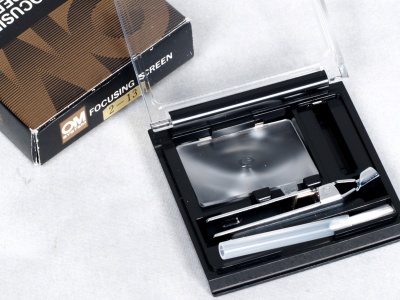
- Einstellscheibe 1-1
- Einstellscheibe 1-2
- Einstellscheibe 1-3
- Einstellscheibe 1-4
- Einstellscheibe 1-4N
- Einstellscheibe 1-5
- Einstellscheibe 1-6
- Einstellscheibe 1-10
- Einstellscheibe 1-13
- Einstellscheibe 1-14
- Einstellscheibe 2-13
Weblinks
- Erfahrungsbericht im DigiCamClub
- „Zuiko Auto-T 1:2/100 mm“ bei om-mania.lix.jp (japanisch)
- "analoger" Test in caverock.net.nz (englisch)
- weiterer Test in "Modern photography" (englisch)
- Test in "Modern photography" (englisch)
- Review von Photography in Malaysia (englisch)
- Ausführliche Beschreibung in mike-lee.org (englisch)
- "Vergleichstest verschiedener 100-mm-Objektive, darunter ein verkratztes Zuiko 100/2, Konstruktionspläne etc." von Marco Cavina (italienisch)
- "Exploded Parts Diagram" bei olympus.dementia.org (über archive.org) (englisch)
- Review des Zuiko Auto-T 1:2/100 mm by phillipreeve.net (englisch)
- Review bei allphotolenses.com (englisch)
- "Guide to Classic Olympus OM Zuiko lenses on film and Sony Full Frame" bei phillipreeve.net (englisch)
- "Olympus 100mm 1:2 Zuiko Auto-T" in nocsensei.com (italienisch)
- "Olympus OM Zuiko 100mm 1:2 E 100mm 1:2.8" in nocsensei.com (italienisch)
Alternativen
Hier werden Alternativen innerhalb des OM-Systems und von Fremdherstellern genannt, die zur Produktionszeit des OM-Systems auf dem Markt waren.
Die Aufzählung ist aber nicht abschließend, es werden - neben einigen Festbrennweiten - auch qualitativ sehr gute Zoomobjektive dargestellt.
Im OM-System
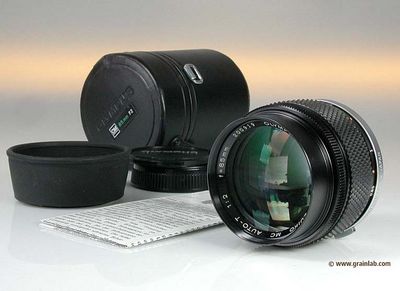
Folgende Objektive des OM-Systems stehen als Alternativen zur Verfügung:
- Zuiko Auto-T 1:2,8/100 mm
- kleiner und leichter (~50%)
- optisch etwas schlechter
- preiswerter, häufiger
- ohne Nahbereichkorrektur (floating Elements) daher Nachgrenze nur 1 m
- Zuiko Auto-T 1:2/85 mm
- kleiner und leichter als das Zuiko Auto-T 1:2,8/100 mm
- optisch ein wenig schlechter (auch abgeblendet)
- preiswerter, häufiger
- Nahgrenze 0,85 m weniger gut
- Zuiko Auto-Makro 1:2/90 mm
- lichtstärker
- Abmessungen und Gewicht sind vergleichbar
- optisch gleichwertig
- spezieller (zusätzlicher) Einsatzzweck: Makroobjektiv
- etwas teurer
E.Zuiko Auto-T 1:2,8/100 mm (M-System) - mit freundlicher Genehmigung von www.newoldcamera.it
E.Zuiko Auto-T 1:2,8/100 mm (OM-System) - mit freundlicher Genehmigung von www.grainlab.com
Zuiko MC Auto-T 1:2/85 mm mit Gegenlichtblende - mit freundlicher Genehmigung von www.grainlab.com
Zuiko MC Auto-T 1:2/85 mm mit Gegenlichtblende, Köcher und Deckel - mit freundlicher Genehmigung von www.grainlab.com
Zuiko Auto-Makro 1:2/90 mm - mit freundlicher Genehmigung von team-foto.com
Zuiko Auto-Makro 1:2/90 mm - mit freundlicher Genehmigung von Foto Brell, Frankfurt
Von Fremdherstellern
Kaum ein Fremdhersteller hatte ein Objektiv mit diesen Kenndaten im Programm, meist handelte es sich um Makroobjektive dieser Brennweitenklasse. Da diese aber eine exzellente Alternative darstellen, sind sie hier aufgeführt. Hier eine Auswahl von empfehlenswerten Objektiven, alle bieten hervorragende hohe optische Leistungen.
- Tamron SP 1:2,5/90 mm - leicht abgeblendet hohe optische Leistungen in allen Bereichen
- Tokina AT-X 1:2,5/90 mm - leicht abgeblendet hohe optische Leistungen, wird von den Fans "Bokina" genannt, lt. unbestätigten Quellen soll es konstruktiv mit dem Vivitar Series 1 1:2,5/90 mm "verwandt sein"
- Vivitar Series 1 1:2,5/90 mm - leicht abgeblendet hohe optische Leistungen, exzellente Haptik, konstruktiv abweichende Vivitar-Objektive gleicher Kenndaten werden zur Abgrenzung im Artikel zum Zuiko Auto-Makro 1:2/90 mm detailliert aufgelistet und dargestellt
Ein sachkundiger Sammler als Japan stellte freundlicherweise Bilder von extrem seltenen Festbrennweiten zur Verfügung:
- Spiratone 1:1,7/85 mm
- Soligor 1:2/100 mm
Mehr ist leider dazu nicht bekannt.
Tamron SP 1:2,5/90 mm - mit freundlicher Genehmigung von camerafoxx
Tokina AT-X 1:2,5/90 mm ("Bokina") - Photos courtesy of 3rdpartylens-om
Vivitar Series 1 1:2,5/90 mm - Photos courtesy of 3rdpartylens-om
Spiratone 1:1,7/85 mm - Photos courtesy of 3rdpartylens-om
OM-Soligor 1:2/100 mm - Photos courtesy of 3rdpartylens-om
Weitere Makroobjektive gemäßigter Brennweite sind in den Artikeln Teleobjektiv und Zuiko Auto-Makro 1:2/90 mm zu finden.
Vergleichbare Produkte der Mitbewerber
Zeitgenössische Objektive
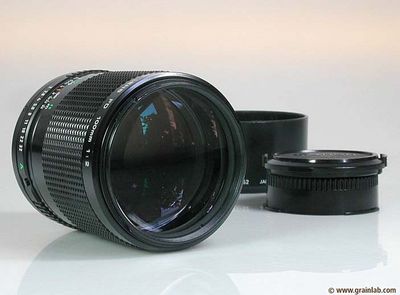
Die damaligen (und teilweise noch heutigen) Mitbewerber hatten u. a. folgende Objektive im Programm:
- Canon FDn 1:2/100 mm - ein optisch hervorragendes Objektiv, welches auch für das Canon EOS-System verfügbar ist
- Minolta Rokkor 1:2/100 mm - leider keine Informationen bekannt
- Nikon Nikkor 1:1,8/105 mm - ein lichtstarkes MF-Objektiv
- Carl Zeiss Planar 1:2/100 mm - für das Contax/Yashica-Bajonett
Canon FDn 1:2/100 mm - mit freundlicher Genehmigung von team-foto.com
Canon FDn 1:2/100 mm - mit freundlicher Genehmigung von team-foto.com
Canon FDn 1:2/100 mm - mit freundlicher Genehmigung von team-foto.com
Canon FDn 1:2/100 mm - mit freundlicher Genehmigung von team-foto.com
Minolta Rokkor 1:2/100 mm - mit freundlicher Genehmigung von www.grainlab.com
Minolta Rokkor 1:2/100 mm - mit freundlicher Genehmigung von camerafoxx
Minolta Rokkor 1:2/100 mm - mit freundlicher Genehmigung von camerafoxx
Minolta Rokkor 1:2/100 mm - mit freundlicher Genehmigung von camerafoxx
Nikon Nikkor 1:1,8/105 mm - mit freundlicher Genehmigung von www.grainlab.com
Nikon Nikkor 1:1,8/105 mm - mit freundlicher Genehmigung von www.grainlab.com
Nikon Nikkor 1:1,8/105 mm - mit freundlicher Genehmigung von www.grainlab.com
Nikon Nikkor 1:1,8/105 mm - mit freundlicher Genehmigung von www.grainlab.com
Carl Zeiss Planar 1:2/100 mm - mit freundlicher Genehmigung von arsenal-photo.com
Carl Zeiss Planar 1:2/100 mm - mit freundlicher Genehmigung von arsenal-photo.com
Carl Zeiss Planar 1:2/100 mm - mit freundlicher Genehmigung von arsenal-photo.com
Carl Zeiss Planar 1:2/100 mm - mit freundlicher Genehmigung von arsenal-photo.com
Carl Zeiss Planar 1:2/100 mm - mit freundlicher Genehmigung von arsenal-photo.com
Interessante (teilw. neuzeitliche) Objektive
Außer Konkurrenz hier ein paar vergleichbare Objektive für Messsucherkameras sowie aus neuerer Produktion:
- Canomatic-R 1:2/100 mm - ein sehr frühes lichtstarkes SLR-Objektiv
- Canon EF 1:2/100 mm - in der optischen Rechnung grob mit dem Canon FDn 1:2/100 mm vergleichbar
- Kinoptik Apochromat 1:2/100 mm - neben Fassungen für Kino-Kameras auch für verschiedene SLR-Anschlüsse verfügbar
- Komura 1:2/100 mm - ein frühes M39-Objektiv
- Leitz APO-Makro-Elmarit-R 1:2,8/100 mm - eins der besten je gebauten Objektive, extrem gute Abbildungsleistungen - weitere Makroobjektive gemäßigter Brennweite sind im Artikel Teleobjektiv zu finden
- Leitz Summicron-M 1:2/90 mm - das erste lichtstarke Objektiv von Leitz für das Leica-M-System, im Bild die erste Version mit dem M39-Schraubgewinde
- Leica Apo-Summicron-R 1:2/90 mm - vergleichbare Rechnung des Apo-Summicron-M 1:2/90 mm, exorbitant teuer
- Nikon AF-DC Nikkor 1:2/105 mm - hier kann die Sphärische Aberration mittels eines Einstellringes verändert ("verschlechtert") werden, damit das Bokeh ansprechender dargestellt wird
- Carl Zeiss Planar 1:1,4/85 mm - bei offener Blende etwas weich, leicht abgeblendet aber optisch exzellent
- Carl Zeiss Sonnar 1:2,8/90 mm - für die Contax G
- Zunow 1:2/100 mm - ein innovativer japanischer Hersteller, der heute (leider) nicht mehr existiert
Canomatic-R 1:2/100 mm - mit freundlicher Genehmigung von arsenal-photo.com
Kinoptik Apochromat 1:2/100 mm - mit freundlicher Genehmigung von arsenal-photo.com
Kinoptik Apochromat 1:2/100 mm - mit freundlicher Genehmigung von Foto Brell, Frankfurt
Kinoptik Apochromat 1:2/100 mm - mit freundlicher Genehmigung von Foto Brell, Frankfurt
Komura 1:2/100 mm - mit freundlicher Genehmigung von arsenal-photo.com
Komura 1:2/100 mm - mit freundlicher Genehmigung von arsenal-photo.com
Komura 1:2/100 mm - mit freundlicher Genehmigung von arsenal-photo.com
Komura 1:2/100 mm - mit freundlicher Genehmigung von arsenal-photo.com
Leitz APO-Makro-Elmarit-R 1:2,8/100 mm - mit freundlicher Genehmigung von arsenal-photo.com
Leica Apo-Summicron-R 1:2/90 mm - mit freundlicher Genehmigung von arsenal-photo.com
Nikon AF-DC Nikkor 1:2/105 mm - mit freundlicher Genehmigung von team-foto.com
Nikon AF-DC Nikkor 1:2/105 mm - mit freundlicher Genehmigung von team-foto.com
Nikon AF-DC Nikkor 1:2/105 mm - mit freundlicher Genehmigung von team-foto.com
Nikon AF-DC Nikkor 1:2/105 mm - mit freundlicher Genehmigung von team-foto.com
Carl Zeiss Planar 1:1,4/85 mm - mit freundlicher Genehmigung von arsenal-photo.com
Carl Zeiss Sonnar 1:2,8/90 mm - mit freundlicher Genehmigung von arsenal-photo.com
Zunow 1:2/100 mm - mit freundlicher Genehmigung von arsenal-photo.com
Beispielaufnahmen

Hier finden Sie eine Reihe von Beispielaufnahmen, die uns freundlicherweise zur Verfügung gestellt wurden:
"Stern" - Zuiko Auto-T 1:2/100 mm (Typ 2) (Offenblende) an einer Canon EOS 5D MkII - mit freundlicher Genehmigung von Helge Kramberger
"Schärfeverlauf in der Landschaft" - Zuiko Auto-T 1:2/100 mm (Typ 2) (Offenblende) an einer Canon EOS 5D MkII - mit freundlicher Genehmigung von Helge Kramberger
"Mohn" (Nahbereich und Bokeh) - Zuiko Auto-T 1:2/100 mm (Typ 2) (Offenblende) an einer Canon EOS 5D MkII - mit freundlicher Genehmigung von Helge Kramberger
"Gebäude" - Zuiko Auto-T 1:2/100 mm (Typ 2) (Offenblende) an einer Canon EOS 5D MkII - mit freundlicher Genehmigung von Helge Kramberger
"Springbrunnen" - Zuiko Auto-T 1:2/100 mm (Typ 2) (Offenblende) an einer Canon EOS 5D MkII - mit freundlicher Genehmigung von Helge Kramberger
"Statue" - Zuiko Auto-T 1:2/100 mm (Typ 2) (Offenblende) an einer Canon EOS 5D MkII - mit freundlicher Genehmigung von Helge Kramberger
"Lamm" - Zuiko Auto-T 1:2/100 mm (Typ 2) (Offenblende) an einer Canon EOS 5D MkII - mit freundlicher Genehmigung von Helge Kramberger
"Unschärfenkreise" - Zuiko Auto-T 1:2/100 mm (Typ 2) (Offenblende) an einer Canon EOS 5D MkII - mit freundlicher Genehmigung von Helge Kramberger
Bitte beachten:
Die tatsächliche Darstellung von Bokeh, Schärfe, Kontrast, Schärfentiefe etc. treten erst bei der Betrachtung in "Vollauflösung" in Erscheinung, hierzu wurden viele Bildbeispiele in Originalgröße (aber stark komprimiert) hinterlegt.
Weitere Beispielaufnahmen sind hier zu finden:
